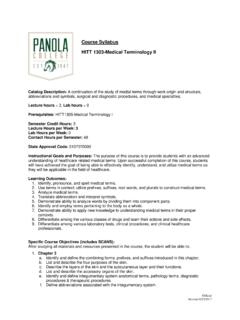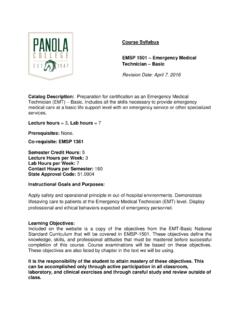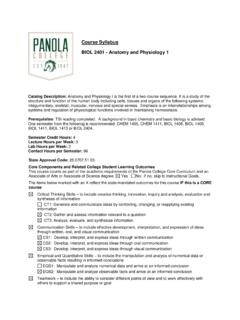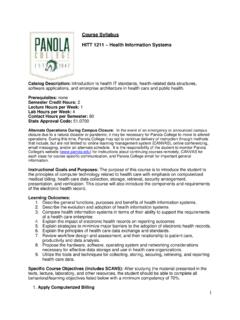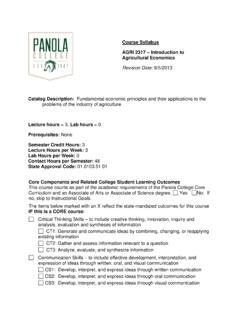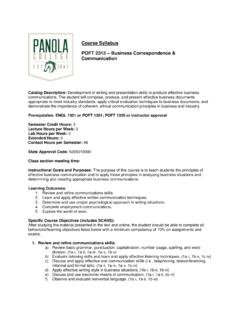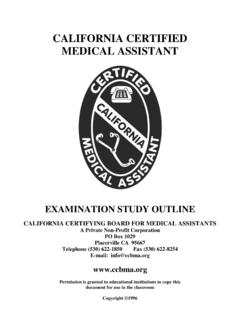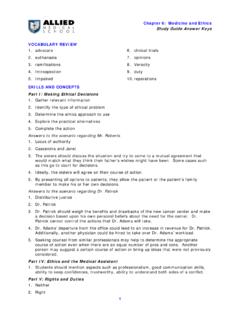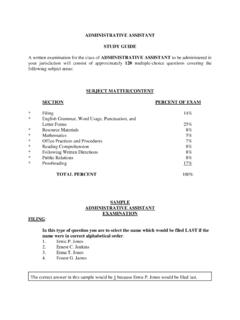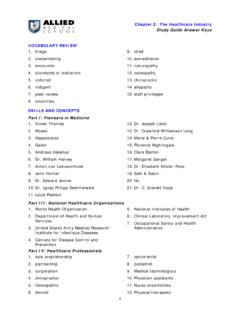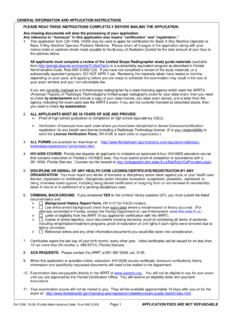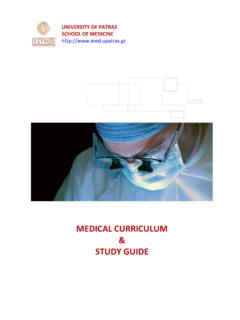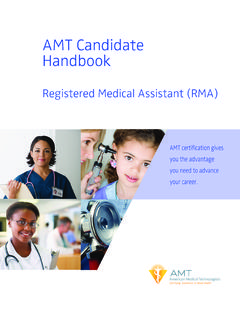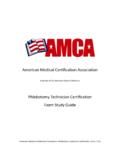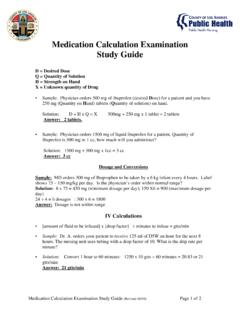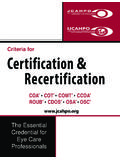Transcription of Course Syllabus MDCA 1254 Medical Assisting Credentialing …
1 Course Syllabus MDCA 1254 Medical Assisting Credentialing Exam Review Catalog Description: A preparation for the National Commission for Certifying Agencies (NCCA) recognized Credentialing exam. (5108010000) Lecture hours = 2, Lab hours = 0 Prerequisites: none Co-requisite: MDCA 2264 Semester Credit Hours: 2 Lecture Hours per Week: 2 Lab Hours per Week: 0 Contact Hours per Semester: 32 State Approval Code: CIP Instructional Goals and Purposes: To Review content of Medical Assisting courses with emphasis in Medical terminology; practice test taking strategies and study techniques; and develop a time management routine for the exam. Learning Outcomes: 1. Review the content of previous Medical Assisting courses 2. Practice test taking strategies and study techniques. 3. Develop time management routine for Medical Assisting (MA) Credentialing exam. 4. Demonstrate knowledge of content and competencies in the Medical Assisting program. 5. Demonstrate general Medical Assisting knowledge.
2 6. Demonstrate administrative Medical Assisting knowledge. 7. Demonstrate clinical Medical Assisting knowledge. Specific Course Objectives (includes SCANS): After studying all materials and resources presented in the Course , the student will be able to: 1. Discuss knowledge of general, administrative, and clinical Medical Assisting (SCANS I Ai) 2. Develop and display test taking strategies and study techniques for the Medical Assisting Certification Exam. (SCANS 1 Aii) 3. Employ a time management schedule for taking the Certified Clinical Medical assistant (CCMA) exam. (SCANS 2Ai) 4. Recognize and discuss content and competencies in the MA program. (SCANS 2 Cii) 5. Describe general patient care, phlebotomy, EKG prep and monitoring, Medical law and ethics, Medical terminology, pathophysiology, and medication guidelines and requirements. (SCANS 2Ai) 6. Describe communication, office administration, office procedures, financial procedures, and risk management as it applies to Medical Assisting .
3 (SCANS 2 Dii,) 2 After studying all materials and resources presented in the Course , the student will be able to: Course Content: A general description of lecture/discussion topics included in this Course are listed in the Learning Objectives section of this Syllabus . Students in all sections of this Course will be required to do the following: 1. Read each section in Certified Medical Administrative assistant (CMAA) study guide 2. Read each section in CCMA study guide 3. Take Administrative Exam 1, 2 and 3 4. Take Clinical Exam 1-6 (Chapters 1-17) 5. Take online practice Exam for CCMA Certification Exam (AT LEAST ONE IS REQUIRED) Methods of Instruction/ Course Format/Delivery: This Course consists of printed study guides for the Administrative and the Clinical portions of the Certification Exam for Medical Assistants. After assigned sections of each study guide are read, the student will take tests online over the material in a testing center on campus by designated due dates.
4 Students also have access to online comprehensive practice exams for CCMA to assist in preparing for the Certification Exam given through National Healthcareer Association (NHA). Major Assignments / Assessments: The following items will be assigned and assessed during the semester and used to calculate the student s final grade. Assignments 1. Read Administrative study guide (CMAA) 2. Read Clinical study guide (CCMA) 3. NHA CCMA Practice Exam(s) Assessment(s): 1. Administrative Exam 1 (Ch. 1-2) 2. Administrative Exam 2 (Ch. 3-4) 3. Administrative Exam 3 (Ch. 5-7) 4. Clinical Exam 1 (Chapters 1 & 2) 5. Clinical Exam 2 (Chapters 3 & 4) 6. Clinical Exam 3 (Chapters 5-7) 7. Clinical Exam 4 (Chapters 8-10) 8. Clinical Exam 5 (Chapters 11-13) 9. Clinical Exam 6 (Chapters 14-17) 10. Online Practice Exam (NHA) Course Grade: The grading scale for this Course is as follows: 3 Administrative exams -50% Clinical exams 50% CCMA Certification Exam (registration) required to pass this Course Texts, Materials, and Supplies: CMAA study guide NHA CCMA study guide NHA Practice exams online ( ) Textbooks/materials used for MA courses Required Readings: CMAA study guide NHA CCMA study guide NHA Recommended Readings: MA Notes ( Davis) Medical Dictionary EKG academy NHA Detailed Test Plan ( ) Other: For current texts and materials, use the following link to access bookstore listings: For testing services, use the following link: If any student in this class has special classroom or testing needs because of a physical learning or emotional condition, please contact the ADA Student Coordinator in Support Services located in the Administration Building or go to for more information.
5 Withdrawing from a Course is the student s responsibility. Students who do not attend class and who do not withdraw will receive the grade earned for the Course . Student Handbook, The Pathfinder: 4 SCANS CRITERIA 1) Foundation skills are defined in three areas: basic skills, thinking skills, and personal qualities. a) Basic Skills: A worker must read, write, perform arithmetic and mathematical operations, listen, and speak effectively. These skills include: i) Reading: locate, understand, and interpret written information in prose and in documents such as manuals, graphs, and schedules. ii) Writing: communicate thoughts, ideas, information, and messages in writing, and create documents such as letters, directions, manuals, reports, graphs, and flow charts. iii) Arithmetic and Mathematical Operations: perform basic computations and approach practical problems by choosing appropriately from a variety of mathematical techniques. iv) Listening: receive, attend to, interpret, and respond to verbal messages and other cues.
6 V) Speaking: Organize ideas and communicate orally. b) Thinking Skills: A worker must think creatively, make decisions, solve problems, visualize, know how to learn, and reason effectively. These skills include: i) Creative Thinking: generate new ideas. ii) Decision Making: specify goals and constraints, generate alternatives, consider risks, and evaluate and choose the best alternative. iii) Problem Solving: recognize problems and devise and implement plan of action. iv) Visualize ("Seeing Things in the Mind's Eye"): organize and process symbols, pictures, graphs, objects, and other information. v) Knowing How to Learn: use efficient learning techniques to acquire and apply new knowledge and skills. vi) Reasoning: discover a rule or principle underlying the relationship between two or more objects and apply it when solving a problem. c) Personal Qualities: A worker must display responsibility, self-esteem, sociability, self-management, integrity, and honesty. i) Responsibility: exert a high level of effort and persevere toward goal attainment.
7 Ii) Self-Esteem: believe in one's own self-worth and maintain a positive view of oneself. iii) Sociability: demonstrate understanding, friendliness, adaptability, empathy, and politeness in group settings. iv) Self-Management: assess oneself accurately, set personal goals, monitor progress, and exhibit self-control. v) Integrity and Honesty: choose ethical courses of action. 2) Workplace competencies are defined in five areas: resources, interpersonal skills, information, systems, and technology. a) Resources: A worker must identify, organize, plan, and allocate resources effectively. i) Time: select goal-relevant activities, rank them, allocate time, and prepare and follow schedules. ii) Money: Use or prepare budgets, make forecasts, keep records, and make adjustments to meet objectives. iii) Material and Facilities: Acquire, store, allocate, and use materials or space efficiently. Examples: construct a decision time line chart; use computer software to plan a project; prepare a budget; conduct a cost/benefits analysis; design an RFP process; write a job description; develop a staffing plan.
8 B) Interpersonal Skills: A worker must work with others effectively. i) Participate as a Member of a Team: contribute to group effort. ii) Teach Others New Skills. iii) Serve Clients/Customers: work to satisfy customer's expectations. 5 iv) Exercise Leadership: communicate ideas to justify position, persuade and convince others, responsibly challenge existing procedures and policies. v) Negotiate: work toward agreements involving exchange of resources, resolve divergent interests. vi) Work with Diversity: work well with men and women from diverse backgrounds. Examples: collaborate with a group member to solve a problem; work through a group conflict situation, train a colleague; deal with a dissatisfied customer in person; select and use appropriate leadership styles; use effective delegation techniques; conduct an individual or team negotiation; demonstrate an understanding of how people from different cultural backgrounds might behave in various situations. c) Information: A worker must be able to acquire and use information.
9 I) Acquire and Evaluate Information. ii) Organize and Maintain Information. iii) Interpret and Communicate Information. iv) Use Computers to Process Information. Examples: research and collect data from various sources; develop a form to collect data; develop an inventory record-keeping system; produce a report using graphics; make an oral presentation using various media; use on-line computer data bases to research a report; use a computer spreadsheet to develop a budget. d) Systems: A worker must understand complex interrelationships. i) Understand Systems: know how social, organizational, and technological systems work and operate effectively with them. ii) Monitor and Correct Performance: distinguish trends, predict impacts on system operations, diagnose deviations in systems' performance and correct malfunctions. iii) Improve or Design Systems: suggest modifications to existing systems and develop new or alternative systems to improve performance. Examples: draw and interpret an organizational chart; develop a monitoring process; choose a situation needing improvement, break it down, examine it, propose an improvement, and implement it.
10 E) Technology: A worker must be able to work with a variety of technologies. i) Select Technology: choose procedures, tools or equipment including computers and related technologies. ii) Apply Technologies to Task: understand overall intent and proper procedures for setup and operation of equipment. iii) Maintain and Troubleshoot Equipment: Prevent, identify, or solve problems with equipment, including computers and other technologies. Examples: read equipment descriptions and technical specifications to select equipment to meet needs; set up and assemble appropriate equipment from instructions; read and follow directions for troubleshooting and repairing equipment.
